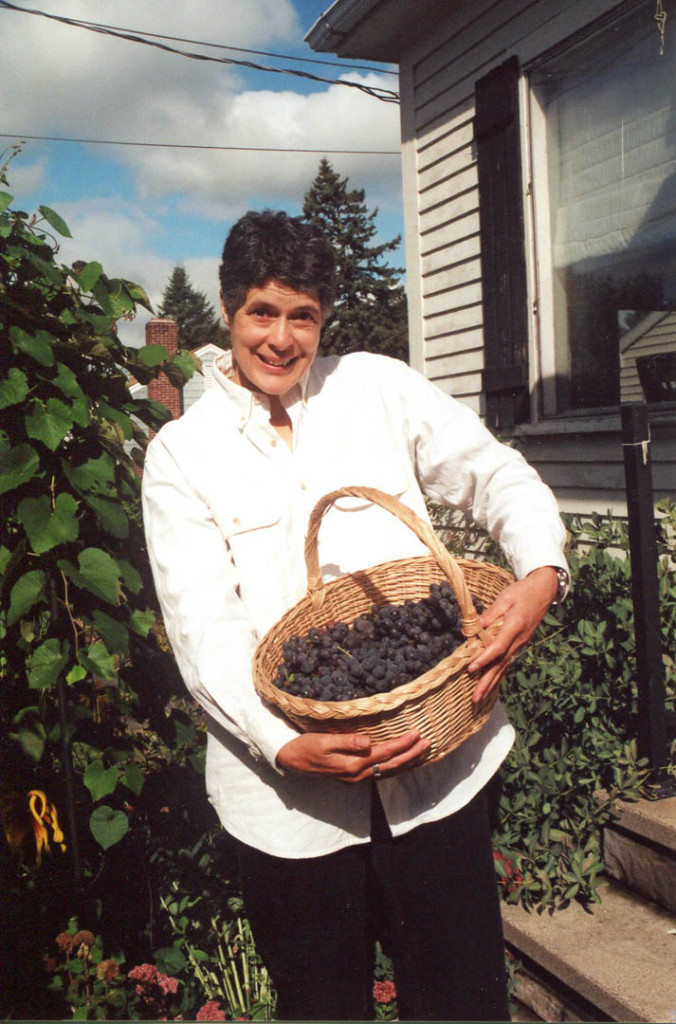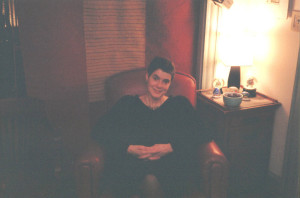Day for Night: Blame It on the Bossa Nova
With Willy Thurston on drums, Day for Night makes its first and last presentation of the bossa nova material, at Alden Bodwell’s house in March 2006. Photos and montage by Jeff Stanton.
How much sense does it make
for a two-piece acoustic band to base its repertoire on both American country music and bossa nova?
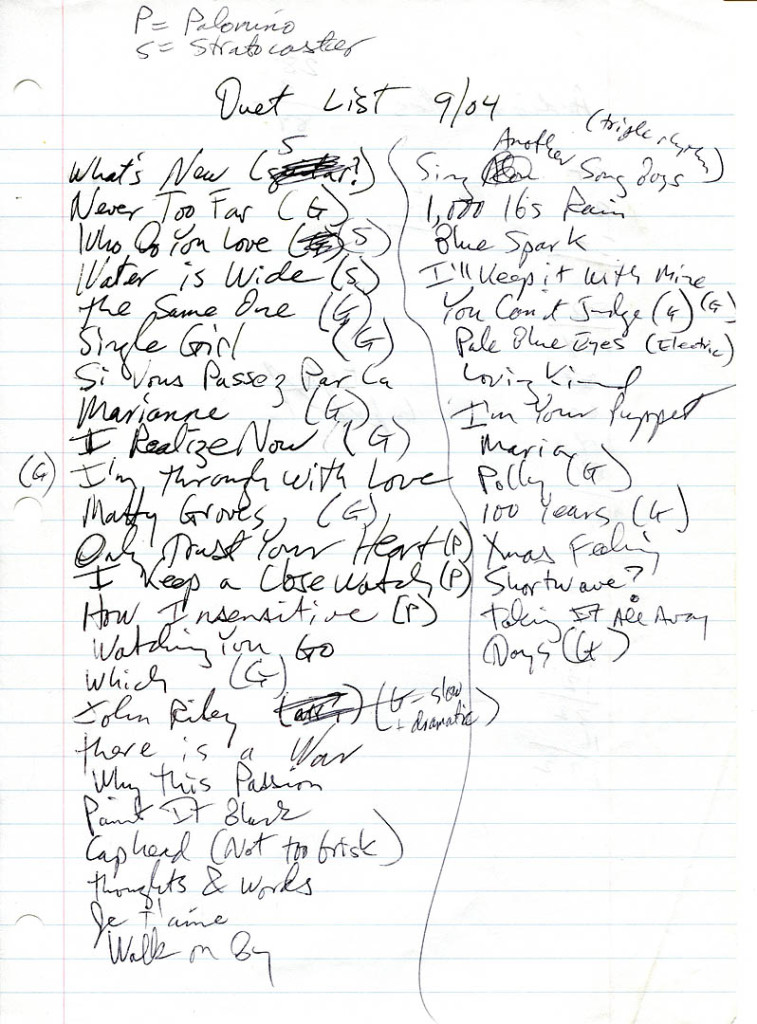
Holding onto the past: Five months after the end of the Howling Turbines, Gretchen and I were still trying to keep the HT repertoire alive. Hubley Archives.
If you should reply, “Not much sense at all, Hoss,” the members of the country band Day for Night would be right there with you — now. But it took us two years of being a bossa nova–country band to figure it out.
His leaving also extended a tendency that had begun a decade previously: an acceptance of shrinkage. I’ve written previously about the comparative virtues of bigger vs. smaller bands: When two members left our band the Cowlix, back in 1994, the remaining trio — Gretchen, I and drummer Jon Nichols-Pethick — liked the resulting maneuverability so much that we never considered replacing the departed musicians.
Similarly, when Ken left, Gretchen and I didn’t even discuss seeking another drummer. In the gap between Jon and Ken, we had spotted some potential in working as a duo. After Ken, we set out to explore that potential.
So there in 2004 we were, facing each other over the Howling Turbines songlist and trying to salvage what we could. It didn’t seem so unreasonable, given the HTs’ success as an acoustic trio. In our new and as yet unnamed configuration, Gretchen switched off between bass and acoustic guitar, and I used electric and acoustic. During the remainder of 2004, we spent more than a few evenings trying different things different ways — but it quickly became evident that most of the old stuff wouldn’t fly. A fresh approach was needed.
But two of the few songs from the HT days that did remain viable were our bossa nova numbers: the Stan Getz setting of Benny Carter and Sammy Kahn’s “Only Trust Your Heart” (unfortunately without Stan Getz) and our own arrangement of John Cale’s “(I Keep a) Close Watch.” I was still captivated by the genre and decided to work up some more.
First off, I needed the right guitar for the job. A questionable habit that I have never broken, in both music and other aspects of life, is that I respond to times of flux or uncertainty by buying things. (Really not a helpful response when, for instance, you lose your job.)
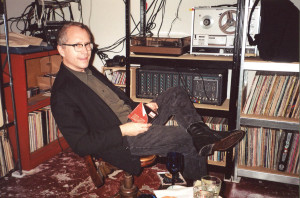
In the studio on the eve of Thanksgiving, 2004, as Gretchen and I made a mixtape for a forthcoming party. Gretchen Schaefer photo.
This time our outlay was for a classical guitar, a new Manuel Rodriguez flamenco model purchased in August 2004 from a now-defunct music store on a wide and sun-drenched highway in Winthrop, Maine. (Thanks to Gretchen, the expedition included a fine picnic lunch of baked chicken, potato salad and white wine, enjoyed on the roadside next to a lake that I now cannot identify.)
Dubbed “The Palomino” by Gretchen on account of its blonde complexion, the Rodriguez had a bright and powerful sound. I adapted quickly to the different feel of wide fretboard and nylon strings (although I never did get used to an intonation problem on the D string).
So there was the guitar on which to play the bossa nova songs. The next problem was, what songs?
Supply was not the problem. As Ross Perot used to say about solutions to national problems, there are all kinds of great bossa nova songs just lying around waiting to be used. Instead, the problem — two problems — was me. First, being neither a trained musician nor intrinsically fascinated by theory, I scarcely knew any of the sophisticated chords that are used in bossa nova. “Only Trust Your Heart” was the frontier of my chordy know-how, and it had taken me quite some time to beat my way out there (a fact I should have paid attention to).
Second, I don’t speak or understand Brazilian Portuguese, which, of course, is the language that classic bossa nova songs tend to be sung in.
A partial solution to the first obstacle was to spend still more money, this time on music books that explicated complicated chords. It was like going back to 1966 and learning guitar all over again as, several times a week after dinner, I hauled out The Palomino, sat on the bed and laboriously tried to get chords into my fingers.
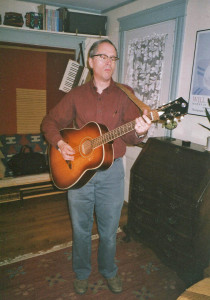
My old friend, the venerable Silvertone, in 2005, 34 years after I got it. Gretchen took this image the night before I sold the guitar to a Bates College student from Rwanda, who sent it home as a gift to her boyfriend. I wonder how it’s doing.
I was a tourist in jazzland: I could follow a map, but didn’t really know where I was. It was yet another reminder (they just keep piling up inside the mailbox) that for all the room for spontaneity you may have as a dilettante, you lack the ultimate freedom that comes with knowing your discipline cold.
But the classic bossa nova songbook, pretty much all in Portuguese, was a heavier lift. It’s true that American lyricists, notably Normal Gimbel, had contrived English lyrics for songs like “Meditação” and “Insensatez.” But I was able to find verbatim translations of some of the original lyrics online and Gimbel’s interpretations, held up to those, just didn’t make it.
For example, Gimbel rendered Vinícius de Moraes’ “Insensatez” as “Insensitive,” in which the narrator is suffering the rejection of an icy-hearted lover. In Portuguese, “insensatez” means folly or foolishness, and in de Moraes’ lyric, the foolishness is the narrator’s adultery, which he is steeling himself to confess.
Now that’s a country song!
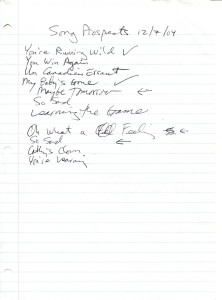
No bossa nova here: These were fodder for the country us, not the bossa us. We still do eight of these songs. Hubley Archives.
Oh, my only one
What have I done
In a man’s delusion?
Oh, this foolishness
That I confess
Will you give me absolution?
Why return to love
To the passion that makes one from two
You said you’d had enough
But now, the moon is new
And the picture you see is so true
It’s the one you dream of
“Meditação” is the only one of the classic bossas that I can still play without prolonged puzzling over the fretboard. Its chords fall under the fingers more readily than elsewhere in the Jobim repertoire. And it may also be true that I simply played it more than any of the others, because it took me so damned long to work up the bossa material.
